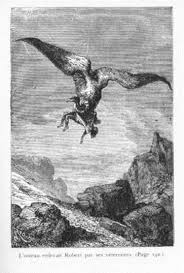
Eagles or Earns, and Gleds [buzzard] are here in plenty and have been very harmfull to the young store: Yea they have been found to seise upon young children and carry them a good way off, and there is a man yet alive who was carried away by an Eagle (while a child) to her nest, but was so speedily by the blessing of God, prevented that no harm was done to him.
(Source: The Description of Orkney, Rev Wallace 1693)
Frequently seen in the hills, is of large size, distinguished from the rest by a band of white encompassing the root of the tail, and the legs being covered with feathers down to the very feet; and it is such prodigious strength that it is said to have carried from a considerable distance to its eyry not only foulis, but lambs, pigs and in some instances young children.’
(Source: Rev Barry c.1791 Description of the Sea eagle)

Sir Walter Scott was told of the eagles’ infamy when he came to Hoy in 1814: The clergyman told us that a man was very lately alive, who, when an infant, was transported from hence by an eagle over a broad sound, arm of the sea to the bird’s nest in Hoy. Pursuit being instantly made, and the eagle’s nest being known, the infant was found there playing with the young eaglets.
A more ludicrous instance of transportation he himself witnessed. Walking in the fields, he heard the squeaking for some time, without being able to discern from whence it proceeded, until looking up, he beheld the unfortunate grunter in the talons of an eagle, who soared away with him towards the summit of Hoy.
(Source: Sir Walter Scott’s Visit to Hoy 16 August 1814)
Mr Hamilton, minister at Hoy Kirk, baptised Dr John Rae in 1813 and later, one of his sons married Marion Rae, sister of the explorer. He had adventures of his own one day walking in his garden at the manse:
Mr Hamilton was disturbed by a loud squeaking, which commenced near his mill, and by degrees grew fainter and fainter. He advanced to the spot, and immediately perceived one of his pigs struggling vainly in the talons of an eagle, who was soaring away with his prey towards the Wart-Hill. There is at present a man living in Orkney, who was seized when a child by an eagle, and was carried a little distance: when the bird, becoming alarmed, dropped him, having but little injured him. Mr Hamilton was more successful in another instance, in inflicting punishment on one of these depredators. An eagle had so effectively entangled his claws in the back of a sheep, that he could not disengage himself, and afforded Mr Hamilton the opportunity of killing him with his stick.
(Source: Saturday Magazine Vol. 7, Supplement for August 1835)

Many stories are told of the great strength of the [Golden] eagle: Wallace mentions a well-authenticated case of one John Hay, who, when a child, was carried off byu one of these birds; and there is at present a woman living in the island of Graemsay, who goes by the name of the ‘Erne’, from a tradition that her grand-mother, when an infant, had nearly likelwise fallen a victim to their rapacity.
(Source: W B Baikie & Robert Heddle Historia naturalis Orcadensis 1884)

